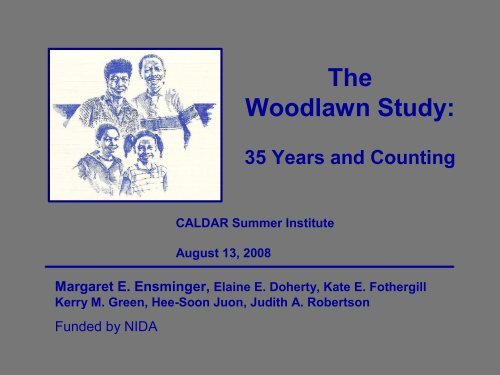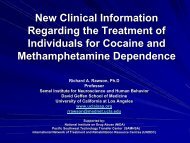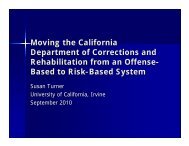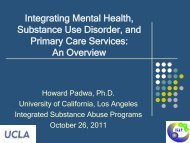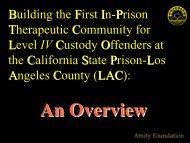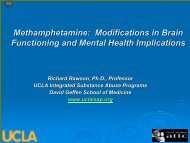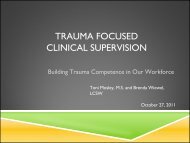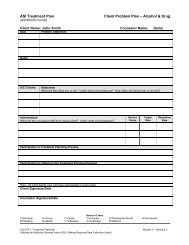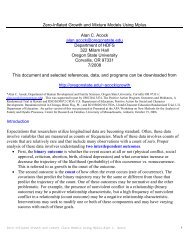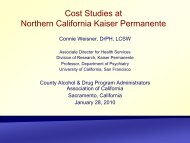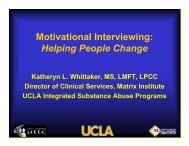The Woodlawn Study: - UCLA Integrated Substance Abuse Programs
The Woodlawn Study: - UCLA Integrated Substance Abuse Programs
The Woodlawn Study: - UCLA Integrated Substance Abuse Programs
Create successful ePaper yourself
Turn your PDF publications into a flip-book with our unique Google optimized e-Paper software.
<strong>The</strong><br />
<strong>Woodlawn</strong> <strong>Study</strong>:<br />
35 Years and Counting<br />
Margaret E. Ensminger, Elaine E. Doherty, Kate E. Fothergill<br />
Kerry M. Green, HeeSoon Juon, Judith A. Robertson<br />
Funded by NIDA<br />
CALDAR Summer Institute<br />
August 13, 2008
<strong>Woodlawn</strong> Collaborators<br />
• Sheppard G. Kellam<br />
• Jeannette Branch*<br />
• Hee Soon Juon<br />
• Joan McCord*<br />
• Judy Robertson<br />
• Kim Sydnor<br />
• Janice Bowie<br />
• Jill Jacobsen Ashman<br />
• Gregory Breeden<br />
• Kate Fothergill<br />
• Kerry Green<br />
• Roslyn Lee<br />
• Sophia Lo<br />
• Chyvette Williams<br />
• Elaine Doherty<br />
*deceased
<strong>Woodlawn</strong> Advisory Board<br />
• Derian King, Convenor<br />
• Rebecca Holbrook<br />
• Earl Hollins<br />
• Annie Jackson*<br />
• Phyllis Jones<br />
• John Marshall<br />
• Fred Ross<br />
• Jeannette Branch*, Consultant<br />
*deceased
Aims of Presentation<br />
• High risk community of First Graders—What<br />
influences later drug use as Adolescents and Adults<br />
• Antecedents and consequences of drug use<br />
• Comparisons of drug use of <strong>Woodlawn</strong> sample with<br />
national samples<br />
• Prevention based on risk factors for drug use<br />
• Advantages and disadvantages of <strong>Woodlawn</strong><br />
longitudinal study design for the study of drug use
<strong>The</strong> <strong>Woodlawn</strong> <strong>Study</strong><br />
• Urban, lowincome, African American communitybased<br />
population<br />
• Followed from age 642<br />
• All first graders in <strong>Woodlawn</strong> public and private schools<br />
• N=1242 (636 females, 606 males)<br />
• Data from cohort members, mothers, teachers and<br />
official school, criminal and death records<br />
• Conceptual Framework—Life Course Social Field
<strong>The</strong> <strong>Woodlawn</strong> Community<br />
<strong>Woodlawn</strong><br />
neighborhood
Census Data (1970):<br />
<strong>Woodlawn</strong> and Chicago<br />
African American<br />
Families (with children
<strong>Woodlawn</strong> Dataset<br />
1950 1960 1970 1980 1990 2000<br />
Birth of<br />
Cohort<br />
(1960)<br />
First Grade<br />
Assessment<br />
(age 6, 1966)<br />
N=1242<br />
Adolescent<br />
Assessment<br />
(age 16, 1976)<br />
N=705<br />
Young Adult<br />
Interview<br />
(age 32, 1992)<br />
N=952<br />
MidAdult<br />
Interview<br />
(age 42, 2002)<br />
N=831
Events for <strong>Woodlawn</strong> Cohort (1)<br />
• Years Age<br />
– 1950s <br />
– 1960 0<br />
– 1960s 0+<br />
– 1966 6<br />
– 1968 8<br />
– 1970s 10+<br />
• Events Affecting Cohort<br />
– Migration from South to Chicago<br />
and <strong>Woodlawn</strong><br />
– Birth of cohort<br />
– Civil rights movement<br />
– First grade<br />
– Assassination of Martin Luther King<br />
– <strong>Woodlawn</strong> Gang Activity<br />
Blackstone Rangers, El Rukins
Events for <strong>Woodlawn</strong> Cohort (2)<br />
• Years Age<br />
– 1978 18<br />
– 1978 18<br />
– 1980s 20+<br />
– 1982 22<br />
– 1983 24<br />
– 1986 26<br />
– 1990s 30+<br />
– 1996 36<br />
– 2008 48<br />
• Events Affecting Cohort<br />
– HS graduation (on time)<br />
– Year of highest student drug use according<br />
to Monitoring the Future<br />
– High Chicago murder rate<br />
– High unemployment<br />
– ElectionMayor Harold Washington<br />
– HIV infection recognized<br />
– Crack/cocaine use increases<br />
– Welfare reform<br />
– Barak Obama candidate for president
Antecedents of Drug Use<br />
• Adolescence<br />
• Young Adulthood<br />
• Mid Adulthood
Social Fields<br />
• First Grade:<br />
– Success at Classroom Tasks<br />
• Aggressive Behavior<br />
• Shy and Withdrawn Behavior<br />
– Family<br />
• Structure<br />
• Interaction Patterns<br />
– Social Resources<br />
• Poverty<br />
• Mother’s Education
Social Adaptation in 1 st Grade<br />
Not Shy or Aggressive<br />
Shy Only<br />
Aggressive Only<br />
Shy and Aggressive<br />
Males<br />
45.0%<br />
16.2%<br />
19.9%<br />
18.9%<br />
Females<br />
58.8%<br />
16.4%<br />
14.4%<br />
10.4%<br />
N=1242, ChiSquare=32.1, 3 df, p
Adolescence
First Grade SAS and Adolescent<br />
Marijuana Use Ever: Males<br />
70<br />
60<br />
50<br />
40<br />
30<br />
20<br />
Never<br />
Moderate<br />
Frequent<br />
10<br />
0<br />
Not shy,<br />
aggress<br />
+shy +aggress +shy &<br />
aggress<br />
Χ 2 =27.0, 6 df, p
Description of <strong>Woodlawn</strong> Respondents<br />
at Early and Mid Adult Interviews<br />
N<br />
Marital Status:<br />
Married<br />
Never married<br />
Children in HH<br />
Completed HS<br />
Employed<br />
Poverty Level:<br />
200%<br />
Incarcerated<br />
Age 3233<br />
952<br />
36%<br />
44%<br />
61%<br />
80%<br />
63%<br />
39%<br />
19%<br />
43%<br />
3.8%<br />
Age 4243<br />
833<br />
42%<br />
31%<br />
56%<br />
82%<br />
74%<br />
26%<br />
11%<br />
53%<br />
2.2%
Shy Behavior in 1st Grade and <strong>Substance</strong> Use<br />
1 st Grade<br />
Adolescence<br />
Age 3233<br />
<br />
Marijuana<br />
Shy<br />
Behavior<br />
<br />
<br />
Marijuana<br />
Cigarettes<br />
All sig at p
Aggressive Behavior in 1 st Grade<br />
and <strong>Substance</strong> Use<br />
1 st Grade<br />
Adolescence<br />
Age 3233<br />
+<br />
Beer/wine<br />
Aggressive<br />
Behavior<br />
+<br />
+<br />
+<br />
Hard liquor<br />
<br />
Marijuana<br />
+<br />
Cigarettes<br />
All sig at p
Shy and Aggressive Behavior in 1st Grade<br />
and <strong>Substance</strong> Use<br />
1 st Grade<br />
Adolescence<br />
Age 3233<br />
Shy and<br />
Aggressive<br />
Behavior<br />
+<br />
+<br />
+<br />
+<br />
Beer/wine<br />
Hard liquor<br />
<br />
Marijuana<br />
Cigarettes<br />
+<br />
+<br />
Cocaine<br />
Cigarettes<br />
All sig at P
Risk and Protective Factors: <strong>Substance</strong> Use by Gender<br />
1 st Grade Adolescence Age 32=33<br />
Social Adaptation<br />
Status<br />
Shy<br />
Aggressive<br />
Metropolitan<br />
Readiness Test<br />
White Arrow=FEMALE<br />
Blue Arrow=MALE<br />
<br />
Adolescent Drug Use<br />
beer/wine<br />
hard liquor<br />
marijuana<br />
cigarettes<br />
<br />
Adolescent Social Bonds<br />
school<br />
family<br />
peers<br />
Young Adult<br />
Drug Use<br />
marijuana<br />
cocaine<br />
Childhood and Adolescent Antecedents of<br />
Marijuana and Cocaine Use<br />
in MidAdulthood: A Longitudinal <strong>Study</strong><br />
Conceptual Framework<br />
1 st Grade Adolescence Young Adulthood MidAdulthood<br />
Family<br />
Socioeconomic<br />
Status<br />
Classroom<br />
Adaptation<br />
School<br />
Achievement<br />
Family<br />
Involvement<br />
Drug Use<br />
Economic<br />
Independence<br />
Educational<br />
Attainment<br />
Family<br />
Involvement<br />
Religious<br />
Involvement<br />
Recent<br />
Drug<br />
Use<br />
Fothergill, KE et al., Pathways to Adult Marijuana and Cocaine Use: A Prospective <strong>Study</strong> of<br />
African Americans from Age 6 to 42. Journal of Health and Social Behavior, in press.
Childhood and Adolescent Antecedents of Marijuana<br />
and Cocaine Use<br />
in MidAdulthood: A Longitudinal <strong>Study</strong><br />
Significant Predictors of Cocaine and/or Marijuana Use In MidAdulthood<br />
Marijuana:<br />
Direct Effects<br />
1 st Grade Shyness (p
Risk and Protective Factors (1)<br />
• Aggression—first grade teacher ratings<br />
– Aggressive behavior risk for drug use in<br />
adolescence for males<br />
– Aggressive behavior risk for cigarette use in<br />
young adulthood for males<br />
– Aggressive behavior indirect effects for drug<br />
use in midadulthood
Risk and Protective Factors (2)<br />
• Shy Behavior—first grade teacher ratings<br />
– Shy behavior is protective for adolescent drug use for<br />
males<br />
– Shy behavior is protective for marijuana use in young<br />
adulthood for females<br />
– Shy behavior is protective for drug use in mid<br />
adulthood
Risk and Protective Factors (3)<br />
• Combined Shy and Aggressive Behavior—<br />
first grade teacher ratings<br />
– Shy and aggressive behavior risk for drug use<br />
in adolescence for males (all drugs)<br />
– Shy and aggressive behavior risk for cigarette<br />
and cocaine use in young adulthood for males
Risk and Protective Factors (4)<br />
• Early Readiness (standardized MRT scores<br />
in first grade)<br />
– Risk for Adolescent drug use for males—those<br />
more ready were more likely to be using drugs<br />
– By young adulthood—those who were ready for<br />
school early were more likely to have ceased<br />
drug use than those less ready
Risk and Protective Factors (5)<br />
• Social Bonds<br />
– Bonds to school and parental supervision<br />
were protective for adolescent drug use for<br />
both males and females.<br />
– Bonds to school and parental supervision in<br />
adolescence were protective for young adult<br />
drug use for females.
Risk and Protective Factors<br />
• Church attendance in young adulthood<br />
was protective for drug use in mid<br />
adulthood (even when controlling for<br />
church attendance in mid adulthood)
Relationships to Other Studies (1)<br />
• Risk and protective factors very similar to those<br />
found in other studies with varying populations<br />
– Early aggressive behavior a very commonly found<br />
risk factor<br />
– Those who have examined the combination of shy<br />
and aggressive behavior also find it a risk<br />
– Shy behavior has not been reported so frequently—<br />
not sure if it is because it hasn’t been examined or<br />
hasn’t been found
Relationships to Other Studies (2)<br />
• Social bonds<br />
– School bonds and parental supervision very<br />
commonly found protective factors in other studies—<br />
most studies have not examined these past early<br />
adulthood<br />
• Early academic achievement<br />
– Shedler and Block found similar relationships with<br />
early academic achievement and adolescent drug<br />
use—more achieving children were more likely to use<br />
drugs as adolescents—may be a cohort phenomenon
Consequences of Drug Use<br />
• Use propensity scores as a way of<br />
understanding consequences of drug use<br />
• Results come from:<br />
• Green, KM, Ensminger, ME, Stuart, E., Fothergill, K. 2008. Adult<br />
Physical and Psychological Health Consequences of Adolescent<br />
<strong>Substance</strong> Use: A Longitudinal <strong>Study</strong> of a CommunityBased<br />
Population of Urban African Americans. Presentation at Society for<br />
Research on Adolescence, Chicago, Il.
Propensity Score Matching<br />
• Statistical technique to handle<br />
confounding in observational data when<br />
attempting to draw causal inferences<br />
• Replicates random assignment with<br />
respect to observed covariates<br />
• Less sensitive to modeling assumptions<br />
than multivariate regression
Consequences at Age 32<br />
of Adolescent Drug Use<br />
High school<br />
dropout 1<br />
Employment 1,2<br />
Adult drug<br />
use 1,2<br />
ns<br />
Adolescent<br />
Drug Use<br />
Criminal<br />
behavior 3<br />
Suicidal<br />
behavior 1<br />
ns<br />
Welfare<br />
status 1<br />
Family<br />
formation 1<br />
1<br />
Green & Ensminger, 2006; 2 Stuart & Green, in press; 3 Green, Ensminger & Stuart, 2007
Effect of Adolescent <strong>Substance</strong> use On<br />
Adult Health<br />
• Does adolescent marijuana/alcohol use<br />
affect adult physical and psychological<br />
health once predisposing factors are<br />
taken into account<br />
• Are the effects of marijuana and alcohol<br />
use the same<br />
• Are there gender differences in<br />
consequences
<strong>Woodlawn</strong> Datasets<br />
Background Covariates<br />
<strong>Substance</strong> Use Variables<br />
Health Outcomes<br />
1950 1960 1970 1980 1990 2000<br />
Birth of<br />
Cohort<br />
(1960)<br />
First Grade<br />
Assessment<br />
(age 6, 1966)<br />
N=1242<br />
Adolescent<br />
Assessment<br />
(age 16, 1976)<br />
N=705<br />
Young Adult<br />
Interview<br />
(age 32, 1992)<br />
N=952<br />
MidAdult<br />
Interview<br />
(age 42, 2002)<br />
N=831
Adult Health Outcomes<br />
• Drug and alcohol use disorders<br />
• HIV risk<br />
• Smoking<br />
• Major depressive disorder<br />
• Poor or fair selfrated physical health<br />
• Mortality
<strong>Substance</strong> Use Variables<br />
• Heavy marijuana use (20+ times by age 16)<br />
– Represents 26% of the population (Male: 36%;<br />
Female: 17%)<br />
• Heavy alcohol use (20+ times by age 16)<br />
– Represents 25% of the population (Male: 36%;<br />
Female:16%)
Matching Variables<br />
• Early health: low birth weight, mothers’ and adolescents’ ratings of<br />
health, hospitalization for injuries and illnesses<br />
• Family history of physical and mental health problems and<br />
mother’s history of alcohol/drug problems<br />
• Family functioning: punishment and affection<br />
• SES: Mother's years of education, number of children in the home,<br />
residential mobility, poverty status, femaleheaded household<br />
• First grade teacher’s rating of aggression, shyness, restlessness,<br />
immaturity, and achievement<br />
• Sex
Covariate Difference Before & After Matching<br />
0.8<br />
0.7<br />
0.6<br />
0.5<br />
0.4<br />
0.3<br />
Heavy MJ users<br />
NonHeavy Users<br />
Matched NonHeavy Users<br />
0.2<br />
0.1<br />
0<br />
Aggression<br />
rating<br />
Achievement<br />
rating<br />
Proportion in<br />
female headed<br />
households
Adolescent Marijuana Use and Adult Health<br />
10<br />
3.59<br />
3.59<br />
Odds Ratios<br />
8<br />
6<br />
4<br />
2<br />
1.96<br />
2.50<br />
3.48<br />
3.58<br />
1.57<br />
1.22<br />
0<br />
AUD<br />
SUD<br />
MDD<br />
HIV Risk<br />
Smoking<br />
SelfRated Health<br />
Mortality
Adolescent Alcohol Use and Adult Health<br />
8<br />
3.87<br />
Odds Ratios<br />
6<br />
4<br />
2<br />
2.74<br />
2.11<br />
1.13<br />
2.53<br />
1.15<br />
0.71<br />
0<br />
AUD<br />
SUD<br />
MDD<br />
HIV Risk<br />
Smoking<br />
SelfRated Health<br />
Mortality
Gender Differences in Results<br />
• No significant differences<br />
• While gender is related to the prevalence<br />
of adolescent substance use and the<br />
prevalence of outcomes, it is not related to<br />
the presence or strength of the association<br />
between them.
Conclusions<br />
• Adolescent substance use is related to<br />
multiple health behaviors and outcomes in<br />
adulthood<br />
• Few differences between effects of<br />
adolescent marijuana and alcohol use<br />
– Notable exception is Adol MJ Use à Adult MDD
Considerations<br />
• Attrition<br />
– Are the heavy substance users with the worst<br />
consequences most likely to drop out<br />
– Are findings underestimated<br />
• Validity of selfreported substance use<br />
during adolescence<br />
• To whom do the results generalize
Comparison of <strong>Woodlawn</strong> Drug Use<br />
with Other Populations<br />
• Special population—how does its drug use<br />
compare with others of the same age<br />
• Crossover effect
<strong>The</strong> Population As Adolescents: Lifetime<br />
<strong>Substance</strong> Use Comparison<br />
Total<br />
Alcohol<br />
Marijuana<br />
Cocaine<br />
Smoking<br />
<strong>Woodlawn</strong><br />
810 th Graders<br />
705<br />
79.7%<br />
61.2%<br />
7.5%<br />
82.2%<br />
Monitoring the Future<br />
12 th Graders 1978*<br />
17,800<br />
93.1%<br />
59.2%<br />
12.9%<br />
75.3%<br />
*Most of <strong>Woodlawn</strong> cohort would have been in 12 th grade in 1978.
Current Drug Use As Adolescents:<br />
Comparison With MTF<br />
<strong>Woodlawn</strong><br />
(past 2 months)<br />
Monitoring the Future<br />
(past 30 days) 1978*<br />
White African Am<br />
Marijuana<br />
53%<br />
50%<br />
40%<br />
Alcohol<br />
74%<br />
75%<br />
49%<br />
Cocaine<br />
6%<br />
8%<br />
5%<br />
Heroin<br />
1.6%<br />
0.8%<br />
0.6%<br />
•Most of <strong>Woodlawn</strong> cohort would have been in 12 th grade in 1978.<br />
•Heroin for MTF is past year
Comments: <strong>Woodlawn</strong> and MTF (1)<br />
• Data not totally comparable<br />
– MTF same cohort but in 12 th grade, <strong>Woodlawn</strong> in 9 th <br />
10 th grade<br />
– Current use—MTF past 30 days, <strong>Woodlawn</strong> past 2<br />
months
Comments: <strong>Woodlawn</strong> and MTF (2)<br />
• Lifetime<br />
– Lifetime alcohol—less for <strong>Woodlawn</strong><br />
– Lifetime marijuana—similar<br />
– Lifetime smoking—more for <strong>Woodlawn</strong><br />
• Current Use<br />
– Alcohol and marijuana similar in rates<br />
– <strong>Woodlawn</strong> frequencies closer to MTF Whites than to<br />
MTF African Americans<br />
– Cocaine and heroin too infrequent for comparisons
Comparison of Lifetime Drug Use<br />
100%<br />
Age 3034<br />
80%<br />
<strong>Woodlawn</strong><br />
60%<br />
NCS<br />
40%<br />
NHSDA<br />
20%<br />
0%<br />
Marijuana<br />
Alcohol<br />
<strong>Woodlawn</strong><br />
Incarcerated<br />
NCS=National Comorbidity Survey (199092) , age 3034, N=1050<br />
NHSDA=National Household Survey on Drug <strong>Abuse</strong> (1992), age 3034<br />
African American, N=286
Comparison of Past Year Drug Use<br />
Age 3034<br />
80%<br />
70%<br />
60%<br />
50%<br />
40%<br />
30%<br />
20%<br />
10%<br />
0%<br />
Marijuana<br />
Alcohol<br />
<strong>Woodlawn</strong><br />
NCS<br />
NHSDA<br />
NCS=National Comorbidity Survey (199092) , age 3034<br />
NHSDA=National Household Survey on Drug <strong>Abuse</strong> (1992), age 3034<br />
African American
Comparison of Past Year Drug Use<br />
Age 34<br />
10%<br />
9%<br />
8%<br />
7%<br />
6%<br />
5%<br />
4%<br />
3%<br />
2%<br />
1%<br />
0%<br />
Cocaine<br />
Heroin<br />
<strong>Woodlawn</strong><br />
NCS<br />
NHSDA<br />
NCS=National Comorbidity Survey (199092) , age 3034<br />
NHSDA=National Household Survey on Drug <strong>Abuse</strong> (1992), age 30 34<br />
African American
Comparison of Lifetime Alcohol and Drug<br />
Dependence, Age 3034<br />
50%<br />
45%<br />
40%<br />
35%<br />
30%<br />
25%<br />
20%<br />
15%<br />
10%<br />
5%<br />
0%<br />
Alcohol<br />
Illicit Drug<br />
<strong>Woodlawn</strong><br />
NCS<br />
NCS=National Comorbidity Survey (199092) , age 3034<br />
NHSDA=National Household Survey on Drug <strong>Abuse</strong> (1992), age 30 34<br />
African American<br />
<strong>Woodlawn</strong> Incarcerated N=36
Comments: <strong>Woodlawn</strong>, NCS and NHSDA<br />
Age 32 (1)<br />
• Comparability High<br />
– <strong>Woodlawn</strong> drug questions modeled on NCS<br />
– All three surveys occurred around the same<br />
time (19901992)<br />
– Data shown is for very similar age cohorts—<br />
ages 3034<br />
– NHSDA data is based on African Americans<br />
from 6 central cities
Comments: <strong>Woodlawn</strong>, NCS & NHSDA<br />
Age 32 (2)<br />
• Lifetime prevalence—<br />
– <strong>Woodlawn</strong> and NCS rates similar for alcohol, marijuana, and cocaine<br />
– NHSDA African American sample—lower on alcohol, marijuana and<br />
cocaine<br />
– <strong>Woodlawn</strong> higher on heroin than both<br />
– <strong>Woodlawn</strong> incarcerated rates much higher on all drugs<br />
• Current Use (Past Year)<br />
– Alcohol—<strong>Woodlawn</strong> lower than other two<br />
– Marijuana, Cocaine, Heroin—<strong>Woodlawn</strong> higher –Crossover effect<br />
• Dependence—<br />
– <strong>Woodlawn</strong> and NCS similar on drug dependence<br />
– <strong>Woodlawn</strong> lower on alcohol dependence
Findings<br />
• Lifetime prevalence of drugs for<br />
<strong>Woodlawn</strong> similar to national study<br />
• Current prevalence of illegal drugs higher<br />
for <strong>Woodlawn</strong> compared to national<br />
study—consistent with crossover effect
Early Risk in Prevention Research<br />
• Over the last four decades much has been learned about<br />
early risk factors and paths leading to drug abuse, and other<br />
behavioral, mental health, and school problems. Many<br />
findings similar to what <strong>Woodlawn</strong> findings have been.<br />
•Aggressive, disruptive behavior as early as 1 st grade has<br />
been repeatedly found a risk factor for later drug and alcohol<br />
abuse and disorders, delinquency, violence, tobacco use,<br />
high risk sex, and other high risk behaviors.
•Kellam and colleagues designed an intervention<br />
program in Baltimore to test whether a classroom<br />
intervention could change aggressive behavior in<br />
first grade and if it did would it impact later<br />
outcomes<br />
•Partially based on <strong>Woodlawn</strong> findings.<br />
Kellam, S. G. et al. 2008. Effects of a universal classroom behavior<br />
management program in first and second grades on young adult behavioral<br />
psychiatric and social outcomes. Drug and Alcohol Dependence, 95,<br />
Supplement 1, June 2008.
Goals of the Good Behavior Game (GBG)<br />
• Provide teachers a classroomwide method to<br />
socialize children into the role of student<br />
• Reduce classroom aggressive, disruptive<br />
behavior among children to enhance<br />
classroom teaching and learning<br />
• Prevent later drug abuse, delinquency, school<br />
failure and other problem outcomes
Design of 1 st Generation Baltimore Trial:<br />
Two Separate Classroom Interventions Aimed<br />
at Aggressive Behavior and Poor Achievement<br />
• 41 1st grade classrooms in 19 schools<br />
• Across schools: 3 or 4 schools in each of 5 low to low/mid<br />
SES urban areas were matched. 70% African American.<br />
Schools in each set were randomly assigned either to the<br />
standard program (control); or to an enhanced curriculum<br />
(Mastery LearningML); or to a classroom behavior<br />
management program (Good Behavior GameGBG).<br />
• Within intervention schools: Children were balanced across<br />
all 1st grade classrooms. 1st grade classrooms and teachers<br />
were randomly assigned to standard program classrooms or to<br />
intervention classrooms.
<strong>Study</strong> Design (continued)<br />
• In the 1 st generation, the GBG trial was done<br />
over 1 st and 2 nd grades in 2 consecutive first<br />
grade cohorts.<br />
• 1 st cohort with 40 hours of teacher training<br />
and support thru the year. This was the<br />
effectiveness trial<br />
• 2 nd cohort with same teachers with little<br />
training and support, tested the sustainability<br />
of results.
GBG vs All Controls on Drug <strong>Abuse</strong> or<br />
Dependence Disorders for Males<br />
Probabaility of Drug <strong>Abuse</strong>/Depend<br />
.8<br />
.6<br />
.4<br />
.2<br />
0<br />
GBG (n = 72 )<br />
All Controls (n = 134 )<br />
1 2 3 4 5 6<br />
Teacher Ratings of Aggression: Fall of 1st Grade<br />
Kellam et al, in press
Impact of GBG done in 1 st and 2 nd Grades on<br />
Regular Smoking by Males by Age 1921<br />
(all controls combined)<br />
Probabaility of Regular Smoker<br />
.8<br />
.6<br />
.4<br />
.2<br />
0<br />
GBG (n = 75 )<br />
All Controls (n = 136 )<br />
1 2 3 4 5 6<br />
Teacher Ratings of Aggression: Fall of 1st Grade
Summary<br />
• Risk and Protective Factors for Adolescent,<br />
Young Adult, and Mid Adult Drug Use in a High<br />
Risk Population were identified.<br />
• Consequences of Adolescent Drug Use in<br />
Adulthood were examined.<br />
• Drug Use in this special population studied in<br />
relation to national samples, by age.<br />
• Results of intervention program that used<br />
<strong>Woodlawn</strong> findings to identify early risks for drug<br />
use and other outcomes.
Cautions of <strong>Study</strong><br />
• Generalizability<br />
• Improvement in Measurement Techniques<br />
between 1966 and 1992<br />
• Self reports of drug use throughout the<br />
study<br />
• Attrition
Unique Aspects of <strong>Study</strong> Design (1)<br />
• Developmental Epidemiology of a Community of<br />
Inner City Children<br />
– Starting with young children means that sample is not<br />
based on who is in school in adolescence<br />
– In adulthood, includes participants who are<br />
incarcerated, homeless—not so in household surveys<br />
– In adulthood, since looking for specific people, may<br />
include those who would not be included in household<br />
surveys<br />
– Issue with generalizability—with <strong>Woodlawn</strong> data<br />
cannot study impact of cohort, ethnicity, age, except<br />
by comparing with other data
Unique Aspects of <strong>Study</strong> Design (2)<br />
• Multiple Sources of Information—Teachers,<br />
Mothers, Children, School, Criminal, Death<br />
Records<br />
– Less confounding of data with use of multiple<br />
sources—teachers’ and mothers’ ratings of behavior<br />
are distinct from child/adolescent view<br />
– Official records give outside information, separate<br />
from self reports—consequences (school dropout,<br />
criminal arrest, death) not influenced by recall bias.
Unique Aspects of <strong>Study</strong> Design (3)<br />
Data Collection over Life Span—Childhood<br />
to Adulthood<br />
• An advantage of initiating study before<br />
drug use has begun<br />
• Obvious advantage of prospectively<br />
collected data
Unique Aspects of <strong>Study</strong> Design (4)<br />
• “Experimental” i.e., intervention data<br />
reinforces results from longitudinal study—<br />
intervention to intervene with early<br />
aggressive behavior influences later<br />
substance use.
• SUPPLEMENTARY SLIDES
<strong>The</strong> Population’s Readiness<br />
in 1 st Grade (MRT)<br />
Unready<br />
Low Normal<br />
Average<br />
High or Superior<br />
Males<br />
17.6%<br />
45.1%<br />
26.2%<br />
11.1%<br />
Females<br />
16.6%<br />
38.6%<br />
32.4%<br />
12.4%<br />
N=1030, ChiSquare=6.5, 3 df, p=.089
School Bonds in Adolescence<br />
High<br />
Medium<br />
Low<br />
Males<br />
30.6%<br />
31.1%<br />
38.3%<br />
Females<br />
42.1%<br />
29.4%<br />
28.5%<br />
n=691, ChiSquare=11.4, 2 df, p=.003


